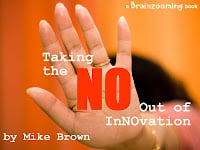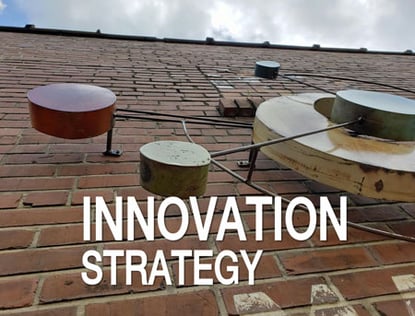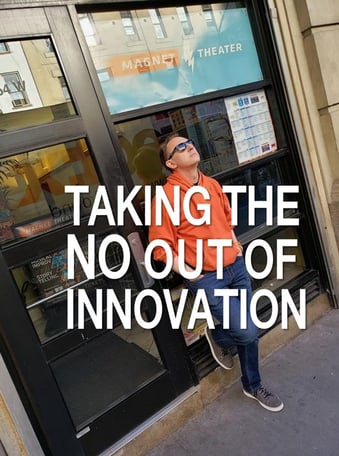 From experience and ongoing business innovation research, there are fairly common situations blocking business innovation across companies. No company has all of these business innovation roadblocks, but the presence of just a couple of barriers will scuttle the most modest dreams of implementing a business innovation program to create value for customers.
From experience and ongoing business innovation research, there are fairly common situations blocking business innovation across companies. No company has all of these business innovation roadblocks, but the presence of just a couple of barriers will scuttle the most modest dreams of implementing a business innovation program to create value for customers.
None of these business innovation NO's are insurmountable, so it's important to understand what causes each of them and some steps to navigate around them and get business innovation going.
1. NO Knack for Innovation
There simply isn't an orientation toward business innovation. It may be a mature industry, a company that's had success with an intense focus, one that's grown through M&A, or has been burned on previous formal innovation efforts. Whatever the reason, innovation doesn't appear to be in the company's DNA.
What Are Some Things You Can Try?
- Why it came seems there is a creative block in your organization
- Challenge conventional wisdom that says innovation isn't vital to the company.
- Target introducing small doses of unconventional strategy to begin.
- Introduce ways to look at the business differently.
- Try to borrow and adapt proven ideas from other industries or markets.
- Feature or downplay key brand elements in your brand
- Infuse common frameworks with extreme creativity
- Identify rich strategic connections between your brand and new opportunities
2. NO Direction
Without a top-level mandate for innovative change, it's tough for a business innovation-oriented culture to flourish. It could be that innovation is outside the company's vision, there's no upper management champion, or a lack of alignment stands in the way of innovation efforts.
What Are Some Things You Can Try?
- Create focus on the fundamental question - "What is the company trying to achieve?" - to figure out what matters and how innovation might fit.
- Articulate your strategic foundation and 0pen multiple potential paths to successful innovation.
- Move beyond the typical answers to business challenges.
- Simply articulate (or at least help do so) what the vision is for innovation.
- Consider starting small - don't worry about big ideas; focus on enough ideas to sort through and find winners.
- Or consider starting big - even if you don't get there, you'll do more than you would have otherwise.
- Challenge and resolve contradictory assumptions, especially those blocking new thinking and progress.
3. NO Rocking the Boat
There's an unmistakable signal from management (whether it's uttered directly or not): "If it isn't broken, don't mess with it. We're not interested in risk taking; let's just maintain the status quo." These messages make it clear that good things don't await those interested in exploring new approaches or trying to do things in different ways.
What Are Some Things You Can Try?
- Understand the fears behind introducing new ideas and innovation.
- Focus on progress within the current model; it won't even feel like the boat is moving, let along rocking.
- Determine how you can influence the business direction without anybody even realizing it.
- Assess the right strategy options for creating change and change management.
- Look for problems or crises (or even crises in other organizations) to force considering changes in how things are done.
- Look for competitors on the horizon that may seem distant or unlikely, yet can be formidable threats.
- Be the first to disrupt your own or other markets.
- Push for extreme ideas and force your competitors' actions.
4. NO Talent Pool
The company may have convinced itself the right people aren't in place to make innovation happen. It could be a perceived lack of "creatives" or "outside the box" thinkers. More likely though, it's a failure to get people with diverse perspectives together and let them work. It's more about diverse talent not working together than not having the right talent in the first place.
What Are Some Things You Can Try?
- Making it safe for everyone to brainstorm and offer new thinking.
- Begin to cultivate strategic thinking skills among your team and anyone else you can influence within your company.
- Actively work to broaden and diversify who is brought into strategic thinking and innovation work.
- Look for experts (even unlikely ones) inside and outside the company available to help.
- Encourage employees to demonstrate creativity and engage customers in innovative ways.
- Make crowd sourcing work harder to introduce new thinking into your organization.
- Exploit social media as a significant external innovation input.
- Involve future-focused customers to share their needs and expectations.
5. There's NO Tomorrow
This NO springs from the conviction things will be won or lost in the short term, so there's little need for long term business innovation development. Or it may be there's no patience for protracted realization of opportunities. If a business innovation is going to be pursued, it needs to be developed and start paying out by the next quarter. In a challenging business economic environment, this sentiment becomes more prevalent.
What Are Some Things You Can Try?
- Brainstorm as many scenarios as possible to identify your best strategic choices.
- Use a solid process for how you think through challenging situations, addressing short term pressures while being mindful of the future.
- Become adept at quickly making solid strategic decisions.
- Get better at handling making mistakes.
- Try to manage around strategic whims within the business with strategic patience; sometimes, that's best done by letting them pass.
- Go to school on the best thinking regarding how to manage innovation during challenging business conditions.
6. NO Resources
As with a "no tomorrow" view, lowered interest in applying resources to business innovation may be more acutely felt right now. The absence of specific resources can be broad, including management attention, available time, and investment dollars. Without these vital inputs, innovation stalls or never takes off in the first place.
What Are Some Things You Can Try?
- When resources are limited, there are opportunities to change the innovation game in your market.
- Take a hard look at what adds value and what doesn't for areas to prune from the business.
- Narrow your activities and free up potential innovation resources by developing a "stop doing" list of low value or off strategy activities to halt.
- Use constrained resources as an opportunity to spur creative thinking and implementation.
- Demonstrate a willingness to be innovative in your approach - how can you introduce and implement new, high-impact ideas with no resources?
7. NO Motivation to Innovate
Something's lacking that dampens an internal drive to innovate. It could be an environment that doesn't promote cooperation, no opportunity to receive credit for your effort, or a lack of other meaningful incentives to bring ideas forward and develop them. The net result is that innovation isn't happening as naturally as it might.
What Are Some Things You Can Try?
- Don't expect to motivate your organization to innovation with meaningless exhortations.
- Be attuned to subtle forms of censorship and protect your innovation team from both internal and external threats.
- Don't encourage management idea killers while finding ways to maximize the impact of idea magnets in your organization.
- Let your employees do the creative thinking since they'll have different perspectives than the management team.
- Celebrate team members who step up to innovation.
- Understand the political fray inside the business and how you can use it to your advantage in securing cooperation and active participation from vital parties.
- Cultivate an informal team, if necessary, of like-minded individuals to help trigger innovation.
- Share ALL the credit. In fact, give away ALL the credit so you can make stars of those whose help you've enlisted.
8. NO Process
There are instances where innovation appears to emanate naturally from within an organization. Chances are though that it's been cultivated and developed through a process, even if it's a relatively small scale and informal one. Without some type of planning and organized means to realize innovation, barriers and bureaucracy can easily block new ideas from coming to fruition.
What Are Some Things You Can Try?
- Employ some type of structured process to collect or generate ideas. Make sure your approach and effort tie back to fundamental business objectives and allow your team to best exploit its skill set.
- Take the best advantage of the value of brainstorming for innovative ideas.
- Work toward a bigger pool of ideas from which to narrow, prioritize and pursue certain ones for implementation.
- Use structure liberally to provide people a means to contribute to ideation, a way to share their perspectives, and a path for implementation.
- Challenge the business to take on "uncomfortable" ideas.
- Take advantage of the other actions you can pursue with innovative ideas your organization has brainstormed.
9. NO Implementation Success
Innovative ideas and concepts are cool, but only have value ultimately if they lead to successful implementation and deliver benefits for the intended audience. There are various roadblocks to successful implementation, including flaws in how ideas are recommended, prioritized, developed, and marketed to target audiences. With all those potential challenges, it's a wonder anything new actually takes place!
What Are Some Things You Can Try?
- Target the underlying reasons why your organization struggles with implementing innovation successfully.
- Make sure the important questions are answered and clear recommendations are made during early stages to focus your implementation plan.
- Select the right project leader with the skill set to bring collaborative innovation to market successfully.
- Make sure to have someone challenge your grand plan.
- "Rehearse" the process you'll use to quickly prototype, develop, test, roll out and troubleshoot ideas to increase your likelihood of implementation success.
- Evaluate the suitability of stealth innovation and skunk works approaches to innovation.
- Hone your organization's ability to appropriately bring project to completion when they are done, even if they aren't perfect.
10. No Measures
It's difficult to sustain a formal business innovation strategy without metrics in place to report return on investment (ROI), showcase positive improvements, and troubleshoot issues. Even earlier in the innovation process, the absence of metrics makes identifying and prioritizing innovation opportunities a shot in the dark. Simply put: no metrics = no hope of long term innovation success.
What Are Some Things You Can Try?
- Determine an overall framework to measure innovation with a variety of metric types.
- Create a metrics dashboard with both quantitative and qualitative innovation metrics.
- Establish a way to revisit unsuccessful implementations to learn from them and apply the lessons to subsequent efforts.
- Review innovation metrics on an ongoing basis to determine when today's innovation will need further innovation in the future.
All the best to you in addressing the specific NO's you face at work that stand in the way of business InNOvation.
If you'd like more information on exploring the personal perspectives you need to approach your whole life more innovatively, you can download an eBook version of "Taking the NO Out of InNOvation." It's a great companion on your mission to bring business innovation to life! – Mike Brown



